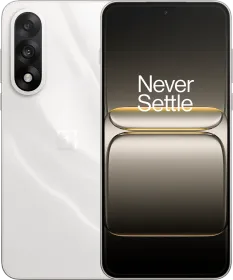Is the OnePlus 13s worth buying in 2025? Can it compete with heavyweights like the iPhone 16e and Galaxy S25 (review) while still being priced under ₹60,000? And what do you give up—if anything—for that price?
These are the questions people are asking as OnePlus launches its latest compact flagship, the OnePlus 13s. In a world where smartphones are getting bulkier and pricier, the 13s is a rare attempt to bring flagship-tier performance, battery life, and design to a more handy and compact form factor and price point.
It comes equipped with a Snapdragon 8 Elite chip, a 5,800mAh battery, and a vibrant LTPO OLED display—a spec sheet that reads more like a phone north of ₹80,000. But there are trade-offs too, particularly in the camera department, and OnePlus has made some bold decisions here.
So, how does it perform in everyday use? Does it justify its pricing in a market flooded with alternatives like the iQOO 13 (review), Xiaomi 15 (review), Realme GT 7 Pro (review), and upcoming Nothing Phone 3? And most importantly, is the OnePlus 13s the best compact phone under ₹60,000 right now? Let’s answer all that and more in this OnePlus 13s review:
OnePlus 13s: Frequently Asked Questions (FAQ)
Q: What color options are available for the OnePlus 13s in India?
A: The OnePlus 13s is available in three color options: Black Velvet, Pink Satin, and Green Silk.
Q: What is the price of the OnePlus 13s in India?
A: The OnePlus 13s starts from ₹54,999 in India. The 12GB RAM + 256GB storage configuration is priced at ₹54,999, and the 12GB RAM + 512GB storage configuration is priced at ₹59,999. SBI Credit Card holders can avail of an instant discount of ₹5,000
Q: When and where can I buy the OnePlus 13s in India?
A3: The OnePlus 13s was launched in India on June 5, 2025. The Oneplus 13s sales commenced on June 12, 2025, and pre-bookings began on June 5, 2025.
Pros
- Compact design with flagship performance
- Excellent battery life
- Bright, color-accurate AMOLED display
- Smooth OxygenOS with long-term updates
- Great thermals and efficient power use
- IR Blaster
- e-SIM support
Cons
- Cameras are competent but unremarkable
- No OIS on the 2X telephoto
- No ultra-fast charging
- Snapshot mode missing
OnePlus 13s Specifications
- Display: 6.32-inch 120Hz ProXDR Display with LTPO, 2640 x 1216 (FHD+) resolution, 460 ppi, 1-120 Hz dynamic refresh rate
- SoC: Snapdragon 8 Elite Mobile Platform (Qualcomm Oryon CPU @4.32GHz, Adreno 830 GPU)
- RAM: 12 GB LPDDR5X
- Storage: 256 GB / 512 GB (UFS 4.0)
- Cameras:
- Main: 50 MP (Sony LYT-700, 1/1.56-inch, f/1.8, OIS)
- Telephoto: 50 MP (S5KJN5, 1/2.75-inch, f/2.0, 2X Optical Zoom)
- Front: 32 MP (1/3.1-inch, f/2.0)
- Connectivity: 5G (n1/n3/n5/n8/n26/n28/n38/n40/n41/n48/n66/n77/n78), Wi-Fi 7 (802.11be), Bluetooth 6.0, NFC
- Biometrics: In-display optical fingerprint sensor
- Dimensions and weight: 15.08 cmx7.17 cmx0.82 cm (8.2 mm); Weight: 185g
- OS: OxygenOS 15.0, Android 15
- Software Updates: 4 years of Android updates and 6-years of securty patches
- IP Rating: IP65
- Battery and Charging: 5,850 mAh, 80W SUPERVOOC, USB Type-C
- Audio: OReality Audio, Noise cancellation support, Support standard Type-C earphones
OnePlus 13s Review: Design and Build
In a market where bigger is often seen as better, the OnePlus 13s design stands out by going smaller, smartly. With a 6.32-inch display, clean aesthetics, and practical engineering, OnePlus proves that flagship experiences don’t need oversized hardware.
While the Samsung Galaxy S25 Edge thins its sides, the OnePlus 13s trims the entire footprint. At just 185g, it’s lighter and more ergonomic than the Xiaomi 15 and iQOO 13, offering true one-handed usability.
OnePlus gives credit to its “S-Structure” internal redesign, which miniaturizes 355 components and stacks the motherboard, reducing internal volume by 30% and reclaiming 60mm²—without affecting performance or battery.
It features 1.34 mm side bezels surrounding the 6.32-inch AMOLED screen, giving the device a 6.1-inch feel. The small bottom chin blends into the frame, making the display dominate its façade. Compared to the Xiaomi 15’s flat aesthetic and the iQOO 13’s curved edges, the OnePlus 13S feels sleeker and more compact.

The aluminum dual-camera island sits neatly in the top-left corner, alongside an LED flash and IR transmitter—though you’ll need to point the phone’s back to use it as a remote. The Black Velvet finish on the rear offers a refined texture that resists fingerprints and elevates the in-hand feel.
Replacing the classic alert slider is the Plus Key, which maintains quick audio profiles (ring, vibrate, silent) while adding programmable shortcuts for flashlight, translation, or quick camera launch.

Despite its slim profile, the OnePlus 13S’s build quality is robust. There’s no flex, and it feels premium without being overbuilt. The IP65 rating offers dust and splash resistance, which is less than the IP68-rated Xiaomi 15, but sufficient for daily use.
Overall, the OnePlus 13S is a compact, thoughtfully built premium phone. Against the Xiaomi 15 and iQOO 13, it holds its own, offering better ergonomics and an understated design. Clearly, the OnePlus 13S is one of 2025’s best compact Android phone designs thus far.
OnePlus 13S Review: Display
The OnePlus 13S features a 6.3-inch display, which is not the largest in its class, but it hits a usability sweet spot. Compared to the Xiaomi 15 or iQOO 13, the 13S feels more pocketable without compromising on screen quality. The 1.5K AMOLED panel delivers a crisp 460 PPI. Everything—from text to images—looks remarkably sharp. Unlike rivals, there is no option to downscale the resolution to FHD+, but the battery holds up well regardless.

The LTPO 1-120Hz refresh rate scales with content, offering 120Hz for scrolling and gaming, 24Hz for movies, and 1Hz for static screens. The result is a smooth experience that’s easy on the battery.
With 800 nits manual, 1600 nits HBM, and 4500 nits peak brightness, the OnePlus 13S holds its own in sunlight, though not quite on par with the Galaxy S25 Ultra or OPPO Find X8 Pro. The 1.1 nits low brightness and 2160Hz PWM dimming are perfect for night use and eye comfort.
It’s a 10-bit panel, so yes—Dolby Vision and HDR10+ are supported across major streaming platforms. However, it’s the subtle touches, such as wet-finger usability, Color Boost, and Image Sharpener, that make this display excel in daily life.
OnePlus 13S Review: Haptics, Sound, and Biometrics
The OnePlus 13S has a pretty decent audio experience. The speakers are loud and crisp, making them great for gaming and watching videos. There’s a tiny imbalance since the earpiece doubles as a speaker, but it still works fine for calls. Plus, the mic quality isn’t too shabby either.
Haptics are also well-implemented. The OnePlus 13S features an X-axis linear motor, resulting in precise and responsive vibrations. Whether you’re typing out a message, adjusting the volume, or navigating the user interface, the haptics offer a tactile and interactive feel. As far as biometrics are concerned, the OnePlus 13S comes with an optical under-display fingerprint reader, which is both snappy and accurate.
OnePlus 13S Review: Software
The OnePlus 13S ships with OxygenOS 15, built on Android 15 based ColorOS. Having said that, this version of OxygenOS feels like OnePlus has finally found its rhythm again. The interface is fast, fluid, and smarter than ever. With four Android updates and six years of security patches, this phone is built for the long haul.

OxygenOS 15 feels notably more responsive than previous iterations. App launches are quick, multitasking transitions are smooth, and the AI features work seamlessly in the background without impacting overall performance
Like most Android phones, the OnePlus 13s comes with a mix of usual Google apps and OnePlus utilities, and unnecessary Netflix and Facebook apps. The IR remote app deserves mention as a genuinely useful addition.

While Xiaomi 15’s HyperOS pushes for ecosystem integration and iQOO 13’s Funtouch OS remains bloated with pre-installed apps, OxygenOS 15 focuses on refinement. App launches are snappy, background tasks are controlled, and animations during multitasking feel smooth even after weeks of use.
What’s new to see is OnePlus’ push to embrace AI. AI Detail Boost, Unblur, and Reflection Eraser quietly fix your photos. Circle to Search is reliable and works effortlessly.
OnePlus added a new feature called AI Plus Mind Space. You can save content from across apps with a simple swipe or tap, and the system intelligently understands and organizes it, like suggesting a calendar event from a WhatsApp message.
OnePlus also added AI VoiceScribe, which can record, summarize, and translate audio across 20+ languages from Zoom meetings to WhatsApp calls. Transcriptions sync into Notes, while real-time subtitles simplify conversations.
There’s also an India-exclusive AI Dialer that adds real-time call translation and summaries. OnePlus also revamped its Notes app, offering auto-summarization, grammar correction, and formality tuning, perfect for switching from casual to professional. OnePlus upgrades its search feature to AI Search, which now uses on-device AI and Gemini cloud AI, to dig through files, chats, and settings using natural language.
Overall, the OxygenOS 15 represents OnePlus at its most mature, combining refined design with genuinely useful AI integration and long-term support commitments. The focus on practical intelligence rather than flashy gimmicks makes this feel like software designed for real users rather than marketing demonstrations.
OnePlus 13S Review: Performance and Benchmarks
The OnePlus 13S’s performance is better than what a compact phone usually delivers. The 12GB LPDDR5X RAM (10.87GB usable) ensures fluid multitasking. App launches are instant, whether you’re switching between Google Docs, Instagram, or high-res image editing in Lightroom, background apps rarely reload.
You consistently get 5GB+ of free RAM, even with dozens of apps open, and Dynamic RAM Expansion adds 12GB from storage if needed. It handles video editing and photo manipulation with ease. Scrubbing through 4K footage or editing RAW photos—all feel buttery smooth. UFS 4.0 storage ensures quick app load times and file transfers. You get 220GB of usable storage out of 256GB (a 512GB variant is also available).
Fitting a Snapdragon 8 Gen Elite into a 6.3-inch chassis sounds like a thermal challenge. But OnePlus nails it. The phone delivers top-tier flagship performance with minimal thermal throttling, a common issue with smaller Android phones. In fact, it outperforms many larger rivals, such as the Xiaomi 15, which is designed to achieve better thermal efficiency.
The phone comes with a 4,400mm² 3D Cryo-Velocity vapor chamber, a cooling system that enables it to run cooler than the Galaxy S25 and Xiaomi 15—both of which struggle to contain heat in similar form factors.
Daily usage on the OnePlus 13S is, in a word, effortless.



Here’s how the OnePlus 13S performs in synthetic benchmarks:
| Benchmark | OnePlus 13s Scores |
| AnTuTu | 21,43,408 |
| CPU Stress Test (50-thread, 30 min) | 535,508GIPS (CPU throttled to 85%) |
| Geekbench 6 (CPU) | Single-Core: 2,232, Multi-Core: 8,558 |
| Geekbench 6 (GPU) | OpenCL: 15074, Vulkan: 15919 |
| 3DMark Wild Life Extreme | 5,944 (Avg. FPS: 35.60) |
| 3DMark Wild Life Extreme Stress Test | Best Loop: 5,209, Lowest Loop: 4,192, Stability: 80.5% |
| AnTuTu Storage Test | 207427 |
Unlike the Xiaomi 15, which tends to throttle under repeated load, the OnePlus 13S maintains stability across multiple benchmark loops. That Wild Life Extreme stress test stability of 78.5% is elite-tier.

Gaming is where the OnePlus 13S truly flexes. In BGMI, the phone maintains a stable 120 FPS with frame boost enabled. Even Genshin Impact and Wuthering Waves run smoothly at 60 FPS without overheating or frame drops.
Even during outdoor use or extended gaming, the phone remains comfortable to hold. No sweaty palms. No thermal throttling. Just sustained, high-performance computing.
OnePlus 13s Review: Cameras
The OnePlus 13S camera system borrows the same main 50MP Sony IMX890 sensor and 50MP 2X telephoto from the OnePlus 13R. The main camera offers a minimum focusing distance of approximately 10cm, while the 2X telephoto lens manages 17cm—both are decent for everyday photography scenarios. However, the absence of optical image stabilization (OIS) on the 2X telephoto is a tough pill to swallow for a phone priced above Rs 50,000, as it compromises photo and video quality in low-light conditions.

The 50MP primary sensor delivers well-balanced images in daylight. The dynamic range is solid, with highlights and shadows preserved without leaning into artificial HDR, and colors pop without appearing cartoonish. Images are sharp, with good edge-to-edge detail. Exposure, however, tends to lean about a stop higher than ideal — something we’ve seen in other OnePlus phones as well. It is better to manually adjust the EV slider in the camera app before taking a photo.
OnePlus’ Hasselblad badging is missing, but their Hasselblad-inspired style filters, such as Fresh, Emerald, and Serenity, are still available, and they do add creative depth.







The 2X telephoto lens features a respectable 17cm minimum focus distance, making it handy for close-up portraits or object shots. However, the lack of optical image stabilization (OIS) is hard to ignore. At this price point (north of ₹50,000), OIS feels like a must-have, and its absence is particularly noticeable in handheld shooting and low-light portrait clarity.


Portrait mode is locked to the 2X focal length, which feels limiting. Unlike Vivo’s X200 series or OPPO’s Find X8 Pro, which offer multi-focal options like 35mm and 50mm, you’re stuck with a single framing. That said, edge detection is mostly accurate, and skin tones are pleasing with natural color rendering, 2x at nightespecially when enhanced by the soft filters.


In low light, the main camera performs reasonably well. The OnePlus 13S captures enough detail and maintains low noise, especially when using Night mode with a tripod. But highlight control often falters in tricky lighting, especially in high-contrast urban scenes.




The telephoto sensor struggles more in low light. In low light, the OnePlus 13S tends to prioritize the use of the primary sensor over the telephoto sensor. The camera tends to use digital zoom far too often and struggles with detail and dynamic range.
The 32MP front camera with autofocus consistently outperforms expectations, even outclassing the larger sensor on the regular OnePlus 13 in certain scenarios. Group selfies come out sharp, the autofocus works well across distances, and the colors are decent.
With the OnePlus 13s’ rear cameras, you can record videos at 4K30/60 and 4K30 on the front. Footage from the main camera is mostly stable, clean, and color-accurate. The 2X telephoto, however, tells a different story. Stabilization is weaker, and without OIS, jitter becomes an issue unless you’re rock steady. Color science is generally consistent across lenses, but exposure control remains a weak spot in video, often requiring manual corrections.
The OnePlus 13 and 13R offer a Snapshot mode, which is missing on the 13s, limiting its spontaneous shooting capabilities.
Is the OnePlus 13s the best camera setup on a compact phone? The 13S is perfectly fine for everyday users, but those seeking the best camera in a compact flagship will likely lean toward the Xiaomi 15 or Pixel 9a. If you are looking for the best camera phone in a similar price segment, you may consider Vivo’s X200 or OPPO Find X8, as both offer more versatile optics and better stabilization.
OnePlus 13S Review: Battery and Charging
The OnePlus 13s delivers outstanding battery performance, considering its compact form factor. It features a 5,850mAh lithium-ion battery, unlike the Silicon Carbide battery found in the OnePlus 13T. It features a single-cell design, unlike the dual-cell configuration found in some faster-charging competitors.
In our day-to-day life, we use the OnePlus 13s as our primary device, equipped with 5G connectivity, and we have the auto brightness setting turned on, along with the occasional use of mobile hotspots. We managed to achieve a minimum of 7 hours of screen-on time, which is impressive. In the PCMark 13 battery test, we achieved 19 hours of battery life.
It comes with an 80W charger, which manages to achieve a 0 to 100 percent charge in 1 hour and 10 minutes—respectable but not particularly fast by current flagship standards. It doesn’t support wireless charging.
Review Verdict: Should You Buy the OnePlus 13S?
The OnePlus 13S is a rare compact flagship that actually feels less compromised. It doesn’t try to out-camera the Vivo X200 or out-spec the Realme GT 7 Pro. Instead, it focuses squarely on what matters most for daily use—performance, battery life, display quality, and software support—and nails those fundamentals.
You get the blazing-fast Snapdragon 8 Gen Elite, paired with a highly efficient 5,800mAh battery that consistently delivers 7–11 hours of screen time. All that in a body that slips easily into your pocket—no trade-offs in heat, weight, or usability.
Indeed, the camera system is where OnePlus falls short. The results are consistent but not class-leading. There’s no OIS on the telephoto video tricks. But for everyday users, it’s more than capable.
The OnePlus 13S makes a strong case under ₹60,000 by prioritizing real-world usability over spec-sheet theatrics. Add in four years of Android updates and six years of security patches, and this becomes a compact phone you can actually live with—happily—for years.
In a world obsessed with bigger and flashier, the OnePlus 13S feels refreshingly intentional.

Smartprix ⭐ Rating: 8.0/10
- Design and Build: 7.5/10
- Display: 8.6/10
- Speakers: 7.7/10
- Software: 7.8/10
- Haptics: 8/10
- Biometrics: 8/10
- Performance: 9/10
- Cameras: 7.5/10
- Battery Life & Charging: 9/10
First reviewed in May 2025.

































